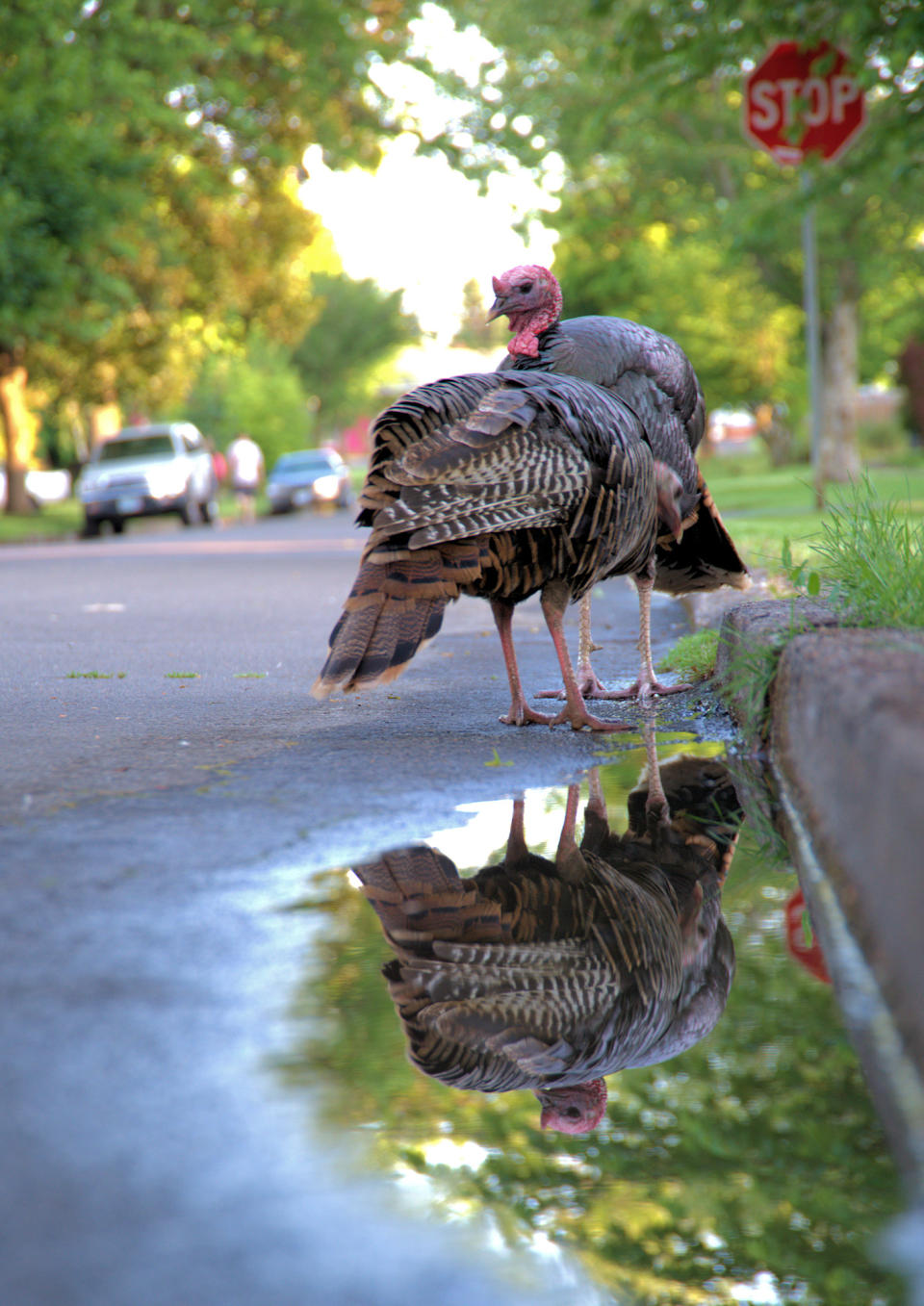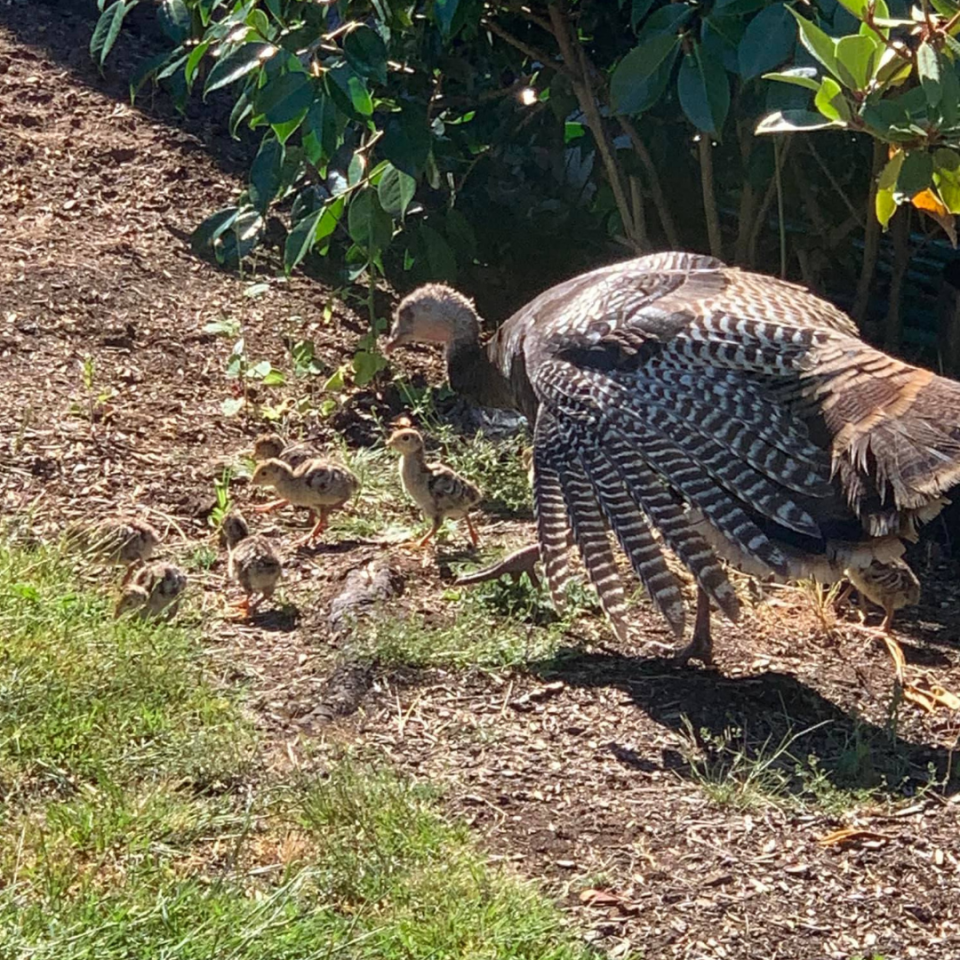Wild turkeys are moving into Salem neighborhoods. Why is that?
This is part of an ongoing series answering "Why is that?" questions about Salem and the Mid-Valley.
The question: Why have wild turkeys moved into Salem neighborhoods? We have some answers. But first, a little history.
The background: Residents tell tales of turkeys not just foraging in their gardens and flower beds but holding up traffic, chasing postal workers, pecking at car tires and pooping everywhere.
Despite all that, Salem has a love affair with its turkeys.
Wild turkeys are not native to Oregon. Early attempts to establish self-sustaining populations in the state were unsuccessful before the 1960s.
The Merriam subspecies was successfully introduced in eastern Oregon in 1961, through the trapping of wild turkeys in Colorado, Arizona and New Mexico. The Rio Grande subspecies was established in 1975 with turkeys from northern California, then Kansas, Oklahoma and Texas.
Most turkeys in Salem are Rio Grande.
As populations have increased, there has been more demand for recreational use. Oregon offers spring and fall hunting opportunities — in designated rural areas, not within city limits — and turkey hunting contributes millions of dollars to the state’s economy, according to the 2018 Oregon Wild Turkey Management Plan.
The original management plan was adopted in 2004 in response to growing populations and the need for direction in harvest management and nuisance abatement. The goal was to maximize hunter opportunities while sustaining the population and to address situations where turkeys could be destructive or menacing.
With wild turkeys expanding in suburban areas and demonstrating an ability to adapt and coexist where people live, including Salem neighborhoods, the ODFW said nuisance complaints will likely increase. They already have.
The ODFW hasn't noticed an uptick in calls in recent months but said it has been getting more calls from Salem the past few years.
The most common complaints from agriculture producers and homeowners are about general nuisance, such as damaging landscaping and gardens. (They have strong feet and legs designed for digging and scratching.)
Less common complaints include fear of turkeys turning aggressive toward humans or attacking pets. (They can be territorial, especially the males during breeding season.)
The ODFW has worked with several municipalities (Corvallis, Dallas, Lebanon, Philomath, Pilot Rock) that have adopted no-feeding-wildlife city ordinances, some specifically addressing wild turkeys.
Salem does not have one, and the ODFW said it has not yet had any discussions with the city.

Why have wild turkeys moved into neighborhoods?
With clusters of trees, sprawling yards, available food and safe shelter, urban and suburban areas provide ideal habitats for wild turkeys. These areas also have fewer predators to breed and safely raise their young.
Wild turkeys generally feed on seeds, nuts, insects and berries.
They also love food left out by people — intentionally or by accident — such as bird seed, pet food, chicken feed and table scraps. Instead of moving on after foraging for natural food, they are likely to stay indefinitely if provided those options.
Wild turkeys seem comfortable living near people and in some cases, so comfortable they become a nuisance.
In Salem, however, the affinity for and interest in these fascinating fowl appears to outweigh any annoyance or inconvenience.
Turkeys have become a source of pride, almost like mascots, in sections of town. Social media posts suggest they have been welcomed.
The Facebook group “Salem Turkey Tracker,” created about six years ago, has nearly 1,900 members and dozens of “top contributors.”
Sightings are regularly posted on the group’s page, with photographs showing turkeys in yards and landscaping areas, on sidewalks and in streets, and on fences and roofs.
The posts typically include a description and location. They have been reported to be strutting, lounging, napping and sunbathing in the neighborhoods.
The area near Candalaria Elementary School in south Salem has been a hotspot in recent months. One photo showed four adult turkeys near the Candalaria sign and breezeway, waiting “for their chicks to get out of school.”
Multiple other sightings have been reported in West Salem.
Last fall, a flock of wild turkeys — also called a rafter — strolled the sidewalk near Clark Creek Park, just a few blocks from bustling Commercial Street SE.
People in passing cars often pull over to grab a snapshot, as if the turkeys are celebrities. Multiple “aww cute” pics were posted this spring and early summer of hens and their chicks.
A new generation of wild turkeys is making Salem their home
Turkeys, in case you were wondering, are polygamous. A single male will breed with multiple hens throughout the spring and early summer, establishing their territories with a gobbling and strutting display. Only males, called "toms," can make the call known as a gobble.
After the mating season, toms and younger “jakes” typically retreat to a separate males-only flock, wandering around separate from the hens. Young female turkeys are known as “jennies.”
A hen builds a ground nest with good cover and lays one egg every 24-32 hours. It takes about two weeks for her to lay a full clutch of nine to 13 eggs. She doesn’t incubate them until all have been laid.

The eggs hatch after a 28-day incubation period. Baby turkeys — called poults — can walk shortly after hatching. They are born with fuzzy feathers and open eyes, can soon run, and will begin roosting in trees within a couple of weeks. Other birds are featherless and blind when they hatch.
The poults from this spring are just about all grown up, with their growth documented by the local tracker group.
While most posters gleefully report sightings, there are a few nuisance posts sprinkled on the page.
Some wild turkeys do not like delivery trucks or persons. A posted video shows turkeys harassing an Amazon delivery vehicle, and a Candalaria resident said their mail carrier has been chased. One person asked the group for advice on preventing damage to gardens and flowers.
Tips for preventing problems with wild turkeys in urban areas
The ODFW provides these tips in its "Living with Wild Turkeys" brochure to prevent problems:
Never intentionally feed wild turkeys.
Keep birdfeeder areas clean. Remove birdfeeders in the spring.
Feed pets inside. Store pet food indoors.
Pick up fallen fruit and nuts.
Fence gardens to keep turkeys out.
If that doesn’t work, non-lethal harassment/hazing may be necessary. But you must contact the ODFW for a permit to legally haze turkeys on your property. It is illegal to harass wildlife without one.
Common hazing techniques that do not injure turkeys but can help deter them from your property include chasing, spraying with a garden hose, setting motion-activated sprinklers, Mylar streamers or scarecrows, and bright lights and noise.
Permits are issued at no cost by calling the local district office in Corvallis, 541-757-4186. The ODFW will discuss the problem, try to identify the underlying cause, and recommend appropriate methods.
Oh, by the way
The story about Benjamin Franklin wanting the national bird to be a turkey is a myth and began, according to The Franklin Institute, due to a letter he wrote to his daughter criticizing the original eagle design for the Great Seal.
In the letter, he described the bald eagle as a “bird of bad moral character” and the turkey “a much more respectable bird, and withal a true original native of America.”
Although Franklin defended the honor of the turkey, he did not propose that it become one of America’s most important symbols.
Capi Lynn is a senior reporter for the Statesman Journal. Email your "Why is that" questions to her at clynn@statesmanjournal.com.
This article originally appeared on Salem Statesman Journal: Why are wild turkeys flocking to Salem neighborhoods?

